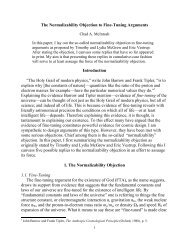Theism and Explanation - Appeared-to-Blogly
Theism and Explanation - Appeared-to-Blogly
Theism and Explanation - Appeared-to-Blogly
You also want an ePaper? Increase the reach of your titles
YUMPU automatically turns print PDFs into web optimized ePapers that Google loves.
24 <strong>Theism</strong> <strong>and</strong> <strong>Explanation</strong><br />
potential explanation only if it is confi rmed in the absolute sense, that is <strong>to</strong><br />
say, if the evidence in its favour makes it more probable than not, <strong>and</strong> if it<br />
has no more probable competi<strong>to</strong>r. 19 More formally, where E is the evidence,<br />
H is a potential explanation of E, <strong>and</strong> K our background knowledge, then<br />
we can regard H as a successful explanation if<br />
Pr(H|E & K) > 0.5<br />
<strong>and</strong> there exists no competing hypothesis whose probability given E <strong>and</strong> K<br />
is higher. 20 The probability of H given E <strong>and</strong> K (its posterior probability)<br />
can be discovered by estimating the prior probability of H <strong>and</strong> the likelihood<br />
of E given H <strong>and</strong> then applying Bayes’s theorem. In its simplest form,<br />
this states that the posterior probability of a hypothesis, given some piece<br />
of evidence (E), is discovered by multiplying the prior probability of H by<br />
the likelihood of E given H, <strong>and</strong> dividing the result by the prior probability<br />
of E.<br />
Pr(H|E) =<br />
Pr(E|H) × Pr(H)<br />
Pr(E)<br />
As we shall see (6.1.2), this is precisely how Swinburne argues.<br />
There are practical diffi culties with a justifi cationist view, particularly<br />
one that appeals <strong>to</strong> Bayes’s theorem. There is, fi rst of all, the diffi culty,<br />
which Swinburne readily acknowledges, 21 of assigning precise numerical<br />
values <strong>to</strong> the probability estimates required. 22 But there are also diffi culties<br />
in spelling out the required conception of probability. Swinburne, for<br />
instance, identifi es three broad categories of probability, which he refers<br />
<strong>to</strong> as “physical,” “statistical,” <strong>and</strong> “inductive.” Physical probability has<br />
<strong>to</strong> do with the propensities that are actually at work in the universe. As<br />
Swinburne puts it, it is “a measure of the extent <strong>to</strong> which some particular<br />
outcome is predetermined by its causes at some earlier time.” 23 In a fully<br />
deterministic universe, every actual event would have a physical probability<br />
of 1.0. Statistical probability, on the other h<strong>and</strong>, is a measure of the<br />
proportion of the members of a class who possess a certain property. 24 But<br />
what really interests Swinburne—<strong>and</strong> what he employs in The Existence<br />
of God—is what he calls “inductive probability.” This is, as Swinburne<br />
writes, “a measure of the extent <strong>to</strong> which one proposition r makes another<br />
one q likely <strong>to</strong> be true.” 25<br />
What about explanations? Does it make sense <strong>to</strong> speak of the probability<br />
of an explana<strong>to</strong>ry hypothesis? Swinburne assumes that since both hypotheses<br />
<strong>and</strong> bodies of evidence are expressed in propositions, inductive probability<br />
can also be applied <strong>to</strong> explanations. The inductive probability of a<br />
hypothesis, on this view, is a measure of how likely it is <strong>to</strong> be true, given



